Over the years with so many different boats paddled, the Evo and now the Evo 2 are on my favorite ski list so lets get that out of the way first. They have not gotten as much press or photo time as my other skis since I rarely race intermediate skis and tend to paddle them more in the winter off season or when I am very tired in my training. I bought my first glass Evo many years ago when my skills were much less than they are today. I sat in that ski the day I bought it and paddled it the day after for 38 miles around Aquidneck Island in some of the roughest conditions I have ever been in. I was hooked on Evos ever since.

Tim and Wesley launching from McCorrie Point. 8 miles later big, scary seas on Ocean Drive.
The Evo II is an intermediate class ski along with the Swordfish, SEI, V10 Sport, S1R, and SR. If you fit in any of these skis, they are all great choices. There are performance,handling and fit differences however in this class they are less pronounced. The outlier in this class is the SR that is the most stable and has the widest, most square bucket. I have paddled all these boats however I paddled the Sport for only for ten minutes after a race but have heard its merits from local paddlers. In order from narrowest bucket to the widest are the Swordfish, Evo 2, S1R, Sport, SEI, SR.
I am often torn between paddling an intermediate ski and a faster high performance ski(HPS). You really need to paddle the ski you are racing to get accustom to the stability and the handling characteristics. So paddling an intermediate ski often defeats this purpose. However, paddling intermediate skis is so much fun since I have ocean conditions available which makes it always interesting. At some point, many paddlers may choose a faster ski to garner more speed and improve their balancing skills. These days many paddlers have two skis in their garage, a faster HPS and an intermediate rough water ski. Over the last three years the line is becoming blurred between intermediate and HPS.
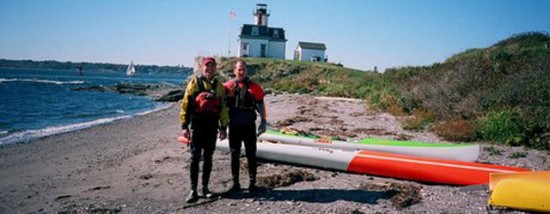
Tim and Wesley(Evo) at Rose Island Light House 2009, mile 17 of 38 mile circumnavigation of Aquidneck Island
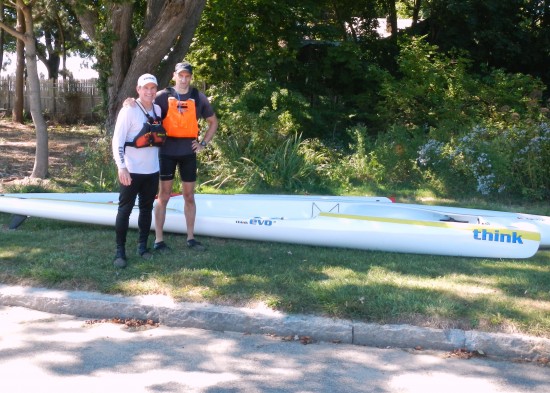
Wesley and Greg after 2013 Kettle Bottom Race in Beverly, Massachusetts
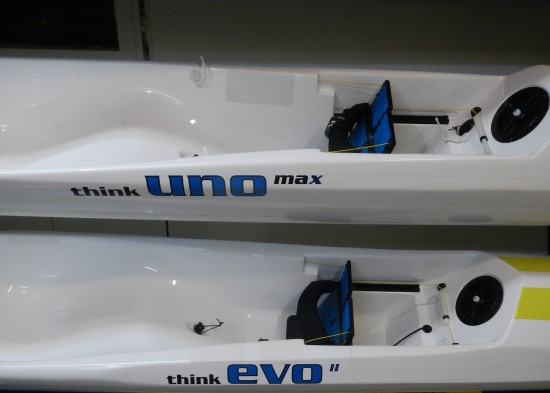
My new Uno Max and Evo II
Beside my Stellars, I have owned more Think surf skis than any other brand including: 6 Evos, 4 Legends, Uno, Uno Max and now Evo II. Throughout my surf ski days, an Evo has been in my garage. I am fond of saying, “if I were not racing, and could only have one ski for paddling it would be an Evo” and now it would be an Evo II. Why?
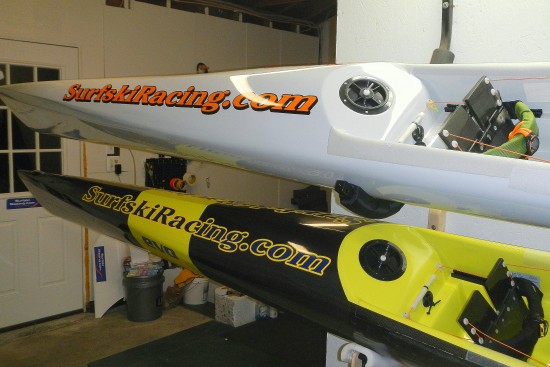
My Carbon Evo and my Refurbished Evo.
The fit on the Evo and now Evo II were almost tailored made for me. So when I think about the pure enjoyment of paddling in New England, I most often think about being in one of my Evo’s. The cockpit is like a great fitting pair of running shoes or a bucket seat of a sports car. It just feels good. You sit in it, take a deep breath and now you are ready to go for that run, take that drive, or go for a paddle. What I have learned over the years with so many skis, the fit is the most important feature of a ski. If the fit is great, you will tolerate variations in speed and stability to a large extent. The best example of this was my original Uno. Despite a learning curve in ocean conditions, the fit was so good, I was willing to put up with the instability while learning to paddle it.
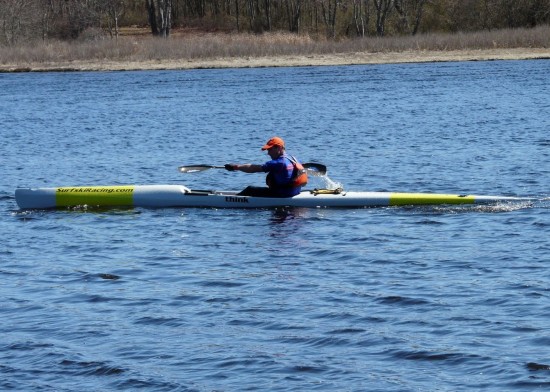
Original Uno 2010 Narrow River Race
A few more photos at above link.
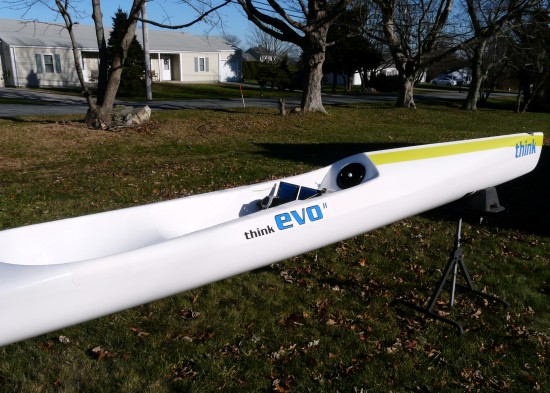
Nice Profile of Evo II
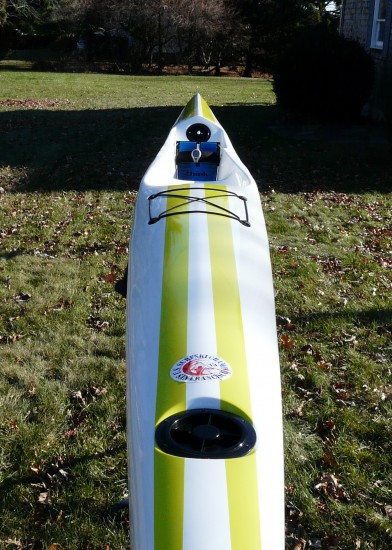
Evo II Profile from back.
Some manufacturers over the years have paid more attention to cockpit design than others. There are many things to consider in designing a cockpit that must be taken into account like the various sizes of paddler’s hips and the best paddling position for most paddlers. Some design constraints are: size, width, depth, shape, height to feet ratio, hump size, slope of the back cockpit, etc. With so many different size paddlers, this is no easy feat. I am lucky that I can fit in any size bucket and with some padding make it work when the bucket is large.
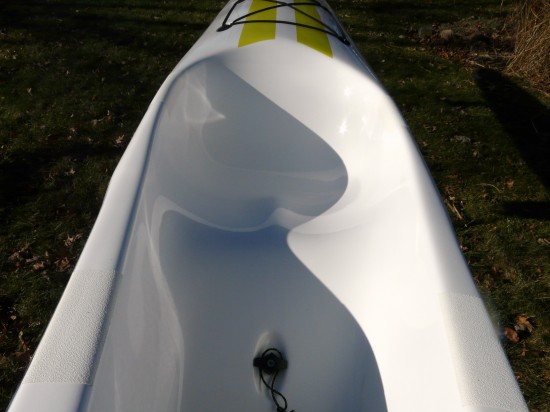
The bucket of Evo II
However, many of you reading this have fewer options. My own experience is that many paddlers are buying skis that are too tight for them. I estimate this to be around 60%. These paddlers often are the ones that have on going stability problems and end up blaming the ski when it really is a fit problem. If a ski is too tight, your stability will suffer greatly. Novice and intermediate paddlers often don’t know what a good fitting ski should feel like. They often think if they can get their butt into a ski than it must fit. This is the reason larger paddlers need to paddle a ski first. Smaller and mid size paddlers still need to demo skis also but they have many more fit options in skis.
For me good fitting skis are the Think boats. Don’t get me wrong, my Hawx has a superb fit, and my V14 and V10 are very enjoyable, all different, but extremely comfortable. As you can see over the years, the cockpits of most brands have gotten better. The Think surf skis tend to have a higher hump that is slightly aft so that it supports your upper thighs while surrounding your outer thigh and calves offering important contact points and enhancing leg drive and stability. Seat to heel height is very good as well. The buckets are narrow, fairly deep, rounded and tapered. Fit as we all know by now, is very personal. However, the bottom line is that I have maximum leg drive with no issues of tight hamstrings, tight hip flexors, and can paddle them for hours on end with a smile on my face.
See Video Below.
Evo 2 Surfski paddled by Wesley Echols, SurfskiRacing.com from Wesley Echols on Vimeo.
The other key features that work for me are the overall speed and stability. Because the fit works so well for me, I can generate excellent leg drive and power with the Evo 2, hence my fourth place finish at the Kettle Island (15 mile ocean race on the North Shore of Massachusetts) on a flat but lumpy day.
https://surfskiracing.org/2013/09/kettle-island-race-2nd-longest-race-of-season-by-wesley-echols/.
Kettle Island Data, GPS data did not transfer before I sent that 310XT back to Garmin to be replaced.
15.27 miles, 8.55 average pace, 2:16.10, Average Heart Rate 157, Max Heart Rate 169.
Below are some of my other GPS times in my Evo II on my time trial courses:
GPS data along with the video of one section of this paddle.
GPS data on my Evo Carbon from a few years ago. Super fast that day. Maybe I need an Evo II in carbon!
Over the years I have had some excellent times in my Evos and now the Evo 2 particulary in downwind conditions where I found it to have superb speed and produced some of best times. The bow rarely buries and if it does it immediately wants to come up. Anytime I can average between 8:15 and 8:30 on my time trial courses than that tells me, an intermediate boat has excellent speed. On a good downwind day I can produce times exceeding this. It maintains its cruising speed well, while tracking nicely even with the 7 inch rudder. I find the flat water speed appropriate for a intermediate ski as well.
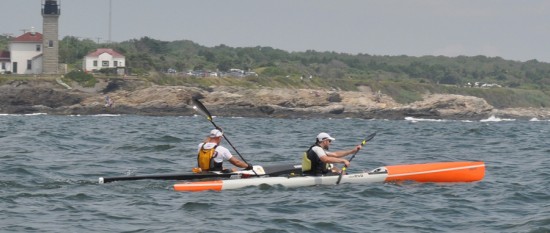
Dave Furniss at 2012 Double Beaver Race placing 2nd. Here he is passing Craig Impens.
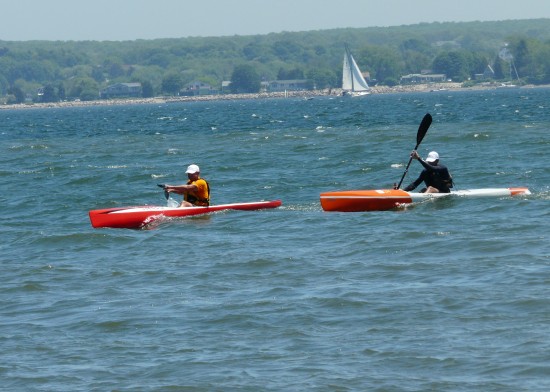
Jan and Flavio(Evo) at previous Sakonnet River Race
Stability compared to the other intermediate skis, the Evo and Evo II are “active” skis that some paddlers will need time to adjust too. I actually prefer the feel of the Evo II because I rarely get bored paddling it and when I transition to a HPS, the transition is not as dramatic as the other intermediate skis.
Foot plate adjustments on all the Think skis have the micro adjustment for the footplate which I find one of the best in the industry. You can get a perfect micro fit. I also really like the way the rudder lines are connected by using the line adjusters forward of the pedals. I also have found on all my Think skis, the tension on the foot pedals suits me perfectly. I like more tension on the pedals so it requires less input while I am leg driving. If you follow the rudder lines back to the rudder compartment you will find a beefy yoke with a nut to secure the rudder along with a set screw that requires an allen wrench. So two tools are needed to secure the rudder. Since I now have two new Thinks skis, the tolerance of the yoke that fits over the rudder shaft is minimal(tight). I suggest you take the yoke off periodically and wash it to make sure it is free and clear. I also check the set screw from time to time along with the rudder lines to make sure everything is working properly. This I do on all my skis. It is nice to have handles for tranport or if you need to tie off you have a secure place to do so. The drain works superbly getting rid of the water very quickly, simple as it gets, effective. It has a built-in leash attachment and small built-in weed guard.

MIcro adjustments for perfect fit

Comfortable contact points for entire leg
So for me the Evo II is a ski that offers everything I want in an intermediate ski: superb fit and comfort offering great leg drive; excellent downwind speed; good flat water speed; and all the stability I need for the big days. That’s why the Evo II is one of my favorite skis! The others are great choices too with the fit, stability, and speed all slightly different which makes reviewing skis great fun. No matter what ski you paddle, fitness training, proper paddling technique and ocean skills are essential in keeping the boat moving efficiently.
Below is the link to the Think USA dealer, Elite Ocean Sports run by Mark McKenzie and Mark Smith who are very knowledgeable about surfskis and professional in how they all approach their respective business and customers.
My next review will be my new V10 Ultra that I have already paddled a few times and time trialed once. The V14 and then Chris’s Huki S1-XL are next. Once this is done I will then add all the boats to my Surf Ski Comparison Chart including the Nelo Vintage, Hawx, Uno Max, V10, V14, and S1-XL Then in the spring I hope to add the new V10L, the Think Ion, Hawk 46, along with the V10 Sport.
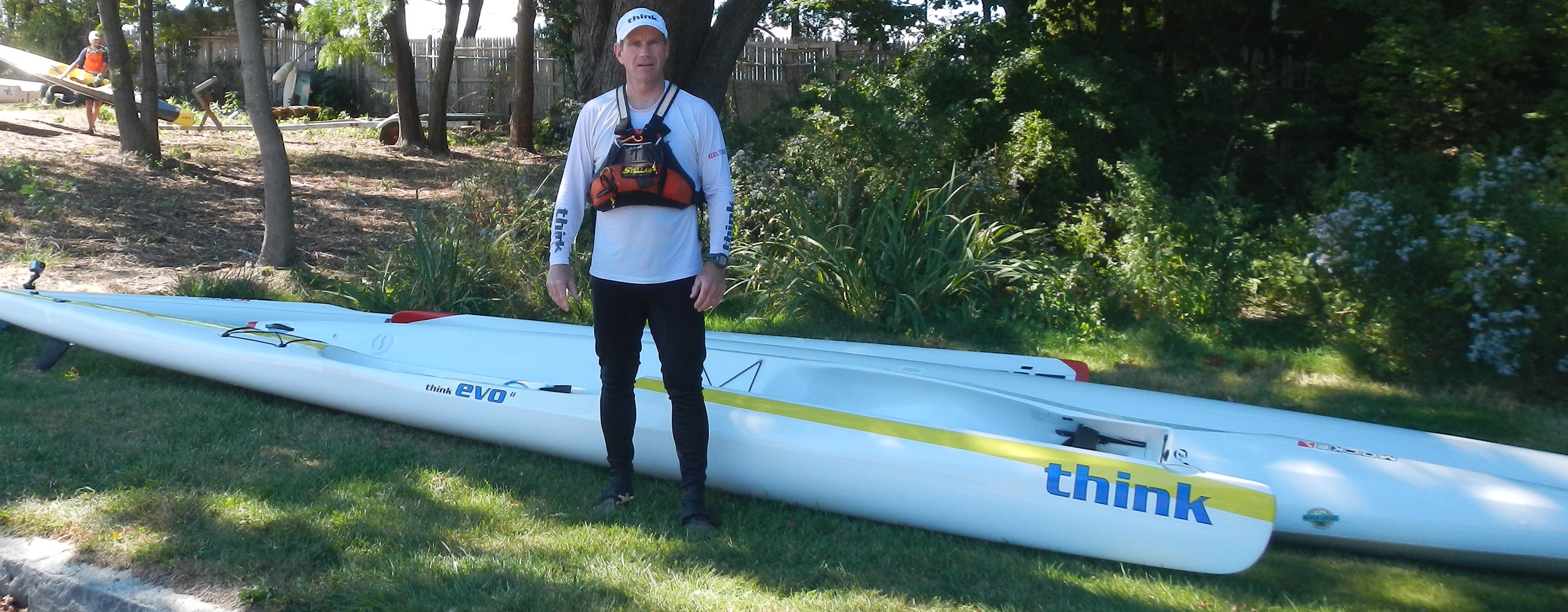













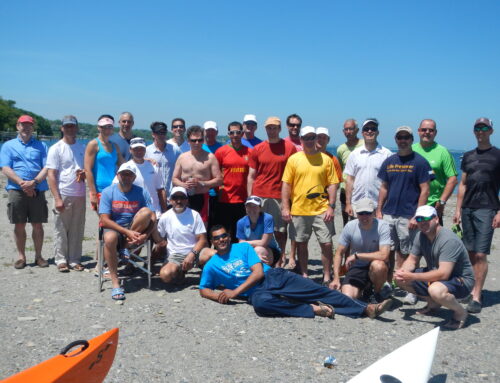
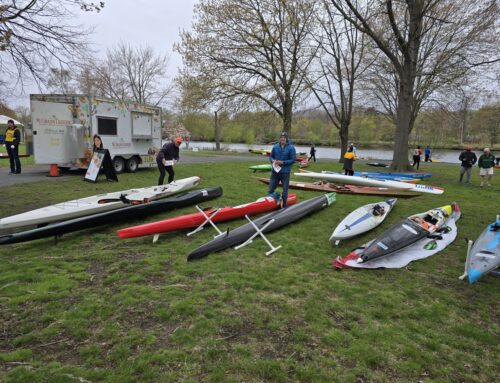
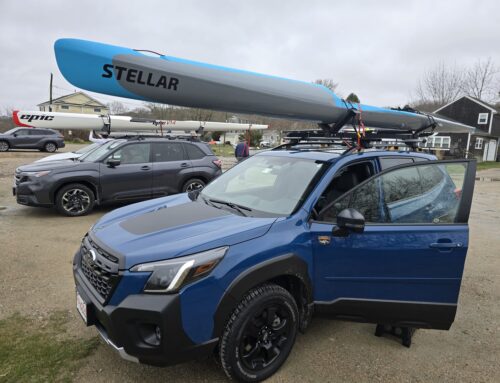
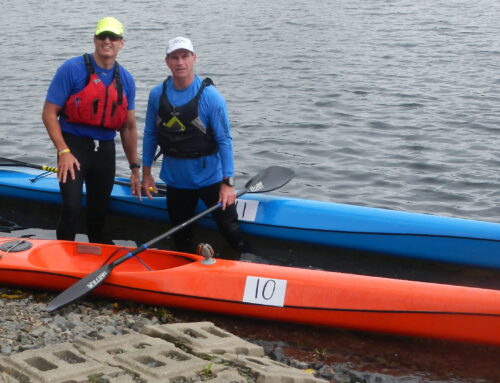
Leave A Comment
You must be logged in to post a comment.